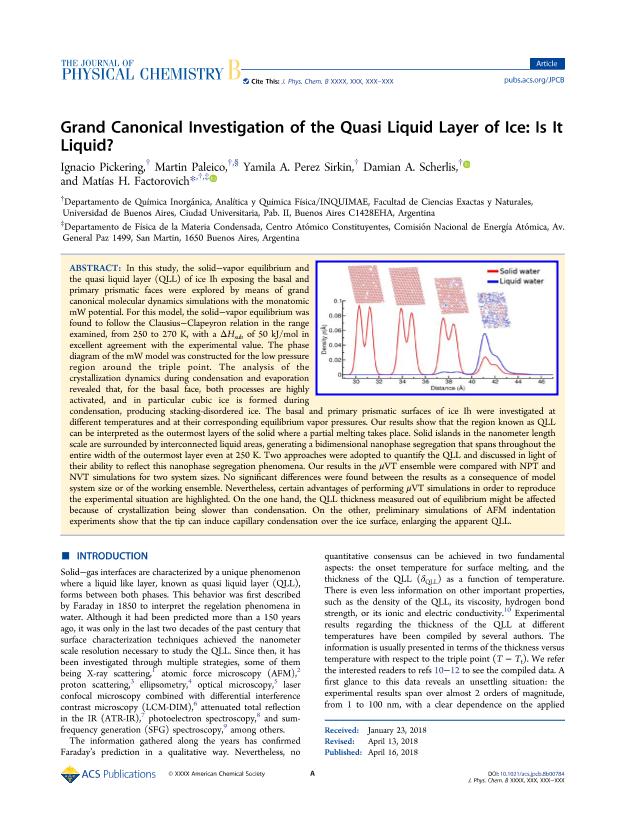Artículo
Grand Canonical Investigation of the Quasi Liquid Layer of Ice: Is It Liquid?
Pickering, Ignacio; Paleico, Martín Leandro; Pérez Sirkin, Yamila Anahí ; Scherlis Perel, Damian Ariel
; Scherlis Perel, Damian Ariel ; Factorovich, Matias Hector
; Factorovich, Matias Hector
 ; Scherlis Perel, Damian Ariel
; Scherlis Perel, Damian Ariel ; Factorovich, Matias Hector
; Factorovich, Matias Hector
Fecha de publicación:
05/2018
Editorial:
American Chemical Society
Revista:
Journal of Physical Chemistry B
ISSN:
1520-6106
Idioma:
Inglés
Tipo de recurso:
Artículo publicado
Clasificación temática:
Resumen
In this study, the solid-vapor equilibrium and the quasi liquid layer (QLL) of ice Ih exposing the basal and primary prismatic faces were explored by means of grand canonical molecular dynamics simulations with the monatomic mW potential. For this model, the solid-vapor equilibrium was found to follow the Clausius-Clapeyron relation in the range examined, from 250 to 270 K, with a δHsub of 50 kJ/mol in excellent agreement with the experimental value. The phase diagram of the mW model was constructed for the low pressure region around the triple point. The analysis of the crystallization dynamics during condensation and evaporation revealed that, for the basal face, both processes are highly activated, and in particular cubic ice is formed during condensation, producing stacking-disordered ice. The basal and primary prismatic surfaces of ice Ih were investigated at different temperatures and at their corresponding equilibrium vapor pressures. Our results show that the region known as QLL can be interpreted as the outermost layers of the solid where a partial melting takes place. Solid islands in the nanometer length scale are surrounded by interconnected liquid areas, generating a bidimensional nanophase segregation that spans throughout the entire width of the outermost layer even at 250 K. Two approaches were adopted to quantify the QLL and discussed in light of their ability to reflect this nanophase segregation phenomena. Our results in the μVT ensemble were compared with NPT and NVT simulations for two system sizes. No significant differences were found between the results as a consequence of model system size or of the working ensemble. Nevertheless, certain advantages of performing μVT simulations in order to reproduce the experimental situation are highlighted. On the one hand, the QLL thickness measured out of equilibrium might be affected because of crystallization being slower than condensation. On the other, preliminary simulations of AFM indentation experiments show that the tip can induce capillary condensation over the ice surface, enlarging the apparent QLL.
Palabras clave:
QLL
Archivos asociados
Licencia
Identificadores
Colecciones
Articulos(INQUIMAE)
Articulos de INST.D/QUIM FIS D/L MATERIALES MEDIOAMB Y ENERGIA
Articulos de INST.D/QUIM FIS D/L MATERIALES MEDIOAMB Y ENERGIA
Citación
Pickering, Ignacio; Paleico, Martín Leandro; Pérez Sirkin, Yamila Anahí; Scherlis Perel, Damian Ariel; Factorovich, Matias Hector; Grand Canonical Investigation of the Quasi Liquid Layer of Ice: Is It Liquid?; American Chemical Society; Journal of Physical Chemistry B; 122; 18; 5-2018; 4880-4890
Compartir
Altmétricas



